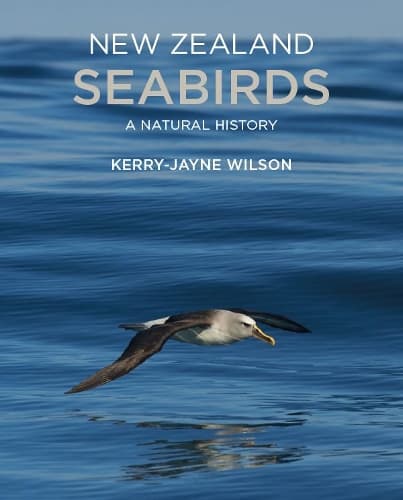Review: New Zealand Seabirds: A natural history
Reviewed by Alex Eagles and Jim Eagles
Seabirds are some of the most amazing animals on the planet yet most people in Aotearoa are unaware of their remarkable life stories and the fact that they are the most threatened group of birds in the world.
New Zealand is known as the seabird capital of the world, with 93 of the world’s 350 varieties breeding here (including 42 species which breed nowhere else). In fact, seabirds make up more than a third of our native birds. Despite this, while most of the population could readily identify a tui or fantail, many New Zealanders would find it difficult to distinguish an albatross from a shearwater. Being a nation of boaties and beachgoers, the general awareness of seabirds in Aotearoa is surprisingly lacking.
Ornithologist Kerry-Jayne Wilson aims to change our perception and increase our knowledge of these birds (and therefore our desire to protect them?) with her new fact-filled book written in an informative but not overly technical and scientific jargon-filled manner.
While New Zealand Seabirds is not a bird identification field guide, it is full of spectacular images from some of the world’s best wildlife photographers and includes majestic albatross soaring over stormy seas, comical little white-faced storm petrel dancing over the waves and penguins ‘flying’ through the water after fish.
This publication is not for experts but for those interested in learning about the whys and wherefores of seabirds. The author draws on her 45 years of researching seabirds to introduce readers to the unknown worlds of more familiar species such as penguins and albatross as well as the equally fascinating petrels and prions. She covers everything from the vast distances travelled to other parts of the world and back again to the complications of chick-rearing and the wide variety of habitats. Also included is an interesting appendix with the scientific, common and Māori names for each species of seabird as well as their conservation status.
I have been fortunate to have many magical moments with seabirds and opportunities to learn numerous facts from experts, but I am happy to say there was much information in this book that I was delighted to discover. This included the reason the variety of seabirds is so numerous in New Zealand waters, which (spoiler alert) is apparently due to the mountains and valleys under the sea and the complex water movements around our island nation.
A favourite section of mine explained the diverse feeding methods of seabirds where I discovered that the dance of the storm petrel was called patter foraging, broad-billed prions hydroplaned, terns engaged in dipping and arctic skuas were pirates!
The information boxes found throughout the text are filled with extra fascinating facts ranging from seabird fossils to the technology used to track seabird movement around the world.
The inclusion of six of the best/easiest places to view these amazing birds around the main islands was another useful addition for readers wishing to see seabirds for themselves.
The last chapter of the book is devoted to the conservation of seabirds where Wilson explains that while the many peculiarities of seabird biology have contributed to their decline much more effort can be put into their preservation. As well as climate change and plastic pollution she includes eradicating introduced predators and weeds on the offshore islands (and few remaining mainland locations) where these birds breed. She also raises the question as to why our Department of Conservation puts more effort “into the conservation of just a few high-profile land birds (such as kiwi and kākāpō) than all our seabirds put together.”
Although there may seem to be a lot of information included in this book, it is not in any great depth. And the text is broken into sections and boxes enabling the reader to select facts in small bites, even randomly, like choosing from a box of chocolates.
Reviewed by Jim Eagles & Alex Eagles
